The Simulator Class¶
The most convenient way to use hera_sim is to use the Simulator class, which builds in all the primary functionality of the hera_sim package in an easy-to-use interface, and adds the ability to consistently write all produced effects into a pyuvdata.UVData object (and to file).
This notebook provides a brief tutorial on basic use of the Simulator class, followed by a longer, more in-depth tutorial that shows some advanced features of the class.
Setup¶
[1]:
import tempfile
import time
from pathlib import Path
import matplotlib.pyplot as plt
import numpy as np
from astropy import units
import hera_sim
from hera_sim import Simulator, DATA_PATH, utils
from uvtools.plot import labeled_waterfall
We’ll inspect the visibilities as we go along by plotting the amplitudes and phases on different axes in the same figure. Here’s the function we’ll be using:
[2]:
def waterfall(sim, antpairpol=(0,1,"xx"), figsize=(6,3.5), dpi=200, title=None):
"""Convenient plotting function to show amp/phase."""
fig, (ax1, ax2) = plt.subplots(
nrows=2,
ncols=1,
figsize=figsize,
dpi=dpi,
)
fig, ax1 = labeled_waterfall(
sim.data,
antpairpol=antpairpol,
mode="log",
ax=ax1,
set_title=title,
)
ax1.set_xlabel(None)
ax1.set_xticklabels(['' for tick in ax1.get_xticks()])
fig, ax2 = labeled_waterfall(
sim.data,
antpairpol=antpairpol,
mode="phs",
ax=ax2,
set_title=False,
)
return fig
Introduction¶
The Simulator class provides an easy-to-use interface for all of the features provided by hera_sim, though it is not to be confused with the VisibilitySimulator class, which is intended to be a universal interface for high-accuracy visibility simulators commonly used within the community. The Simulator class features:
A universal
addmethod for simulating any effect included in thehera_simAPI.More advanced users can create their own custom effects that the
Simulatorcan use, as long as these custom effects abide by a certain syntax.
A
getmethod for retrieving any previously simulated effect.Simulated effects are not cached, but rather the parameters characterizing the effect are recorded and the desired effect is re-simulated.
Four modes of specifying how to configure the random state when simulating effects:
“redundant” ensures that the random state is set the same for each baseline within a redundant group;
“once” uses the same random state when simulating data for every baseline in the array;
“initial” only sets the random state initially, prior to simulating data for the array;
Similar to “once”, the user can provide an integer to seed the random state, which is then used to set the random state for every baseline in the array.
Convenient methods for writing the data to disk.
The
writemethod writes the entireUVDataobject’s contents to disk in the desired format.The
chunk_sim_and_savemethod allows for writing the data to disk in many files with a set number of integrations per file.
In order to enable a simple, single interface for simulating an effect, hera_sim employs a certain heirarchy to how it thinks about simulated effects. Every simulation effect provided in hera_sim derives from a single abstract base class, the SimulationComponent. A “component” is a general term for a category of simulated effect, while a “model” is an implementation of a particular effect. Components track all of the models that are particular implementations of the components, and
this enables hera_sim to track every model that is created, so long as it is a subclass of a simulation component. To see a nicely formatted list of all of the components and their models, you can print the output of the components.list_all_components function, as demonstrated below.
[3]:
print(hera_sim.components.list_all_components())
array:
lineararray
hexarray
foreground:
diffuseforeground | diffuse_foreground
pointsourceforeground | pntsrc_foreground
noise:
thermalnoise | thermal_noise
rfi:
stations | rfi_stations
impulse | rfi_impulse
scatter | rfi_scatter
dtv | rfi_dtv
gain:
bandpass | gains | bandpass_gain
reflections | reflection_gains | sigchain_reflections
crosstalk:
crosscouplingcrosstalk | cross_coupling_xtalk
crosscouplingspectrum | cross_coupling_spectrum | xtalk_spectrum
whitenoisecrosstalk | whitenoise_xtalk | white_noise_xtalk
eor:
noiselikeeor | noiselike_eor
The format for the output is structured as follows:
component_1:
model_1_name | model_1_alias_1 | ... | model_1_alias_N
...
model_N_name | model_N_alias_1 | ...
component_2:
...
So long as there are not name conflicts, hera_sim is able to uniquely identify which model corresponds to which name/alias, and so there is some flexibility in telling the Simulator how to find and simulate an effect for a particular model.
Basic Use¶
To get us started, let’s make a Simulator object with 100 frequency channels spanning from 100 to 200 MHz, a half-hour of observing time using an integration time of 10.7 seconds, and a 7-element hexagonal array.
[4]:
# Define the array layout.
array_layout = hera_sim.antpos.hex_array(
2, split_core=False, outriggers=0
)
# Define the timing parameters.
start_time = 2458115.9 # JD
integration_time = 10.7 # seconds
Ntimes = int(30 * units.min.to("s") / integration_time)
# Define the frequency parameters.
Nfreqs = 100
bandwidth = 1e8 # Hz
start_freq = 1e8 # Hz
sim_params = dict(
Nfreqs=Nfreqs,
start_freq=start_freq,
bandwidth=bandwidth,
Ntimes=Ntimes,
start_time=start_time,
integration_time=integration_time,
array_layout=array_layout,
)
# Create an instance of the Simulator class.
sim = Simulator(**sim_params)
Overview¶
The Simulator class adds some attributes for conveniently accessing metadata:
[5]:
# Observed frequencies in GHz
sim.freqs[::10]
[5]:
array([0.1 , 0.11, 0.12, 0.13, 0.14, 0.15, 0.16, 0.17, 0.18, 0.19])
[6]:
# Observed Local Sidereal Times (LSTs) in radians
sim.lsts[::10]
[6]:
array([4.58108965, 4.58889222, 4.59669478, 4.60449734, 4.61229991,
4.62010247, 4.62790503, 4.6357076 , 4.64351016, 4.65131273,
4.65911529, 4.66691785, 4.67472042, 4.68252298, 4.69032555,
4.69812811, 4.70593067])
[7]:
# Array layout in local East-North-Up (ENU) coordinates
sim.antpos
[7]:
{0: array([-7.30000000e+00, 1.26439709e+01, -4.36185665e-09]),
1: array([ 7.30000000e+00, 1.26439709e+01, -3.99203159e-09]),
2: array([-1.46000000e+01, 6.98581573e-09, -4.65185394e-09]),
3: array([ 0.00000000e+00, 7.20559015e-09, -4.28202888e-09]),
4: array([ 1.46000000e+01, 7.42536457e-09, -3.91220382e-09]),
5: array([-7.30000000e+00, -1.26439709e+01, -4.57202631e-09]),
6: array([ 7.30000000e+00, -1.26439709e+01, -4.20220125e-09])}
[8]:
# Polarization array
sim.pols
[8]:
['xx']
You can also generate a plot of the array layout using the plot_array method:
[9]:
fig = sim.plot_array()
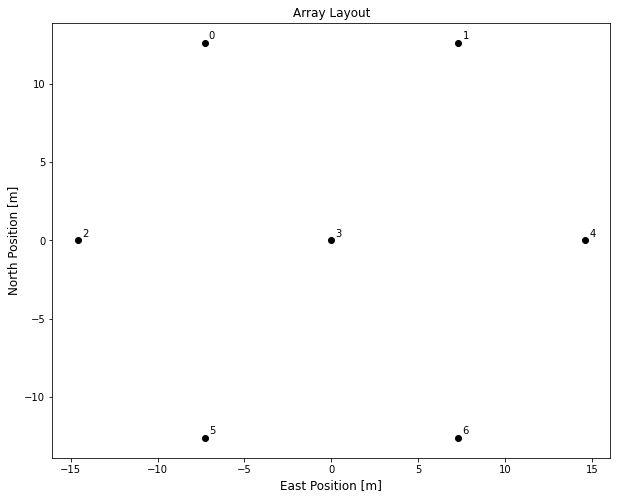
The data attribute can be used to access the UVData object used to store the simulated data and metadata:
[10]:
type(sim.data)
[10]:
pyuvdata.uvdata.uvdata.UVData
Adding Effects¶
Effects may be added to a simulation by using the add method. This method takes one argument and variable keyword arguments: the required argument component may be either a string identifying the name of a hera_sim class (or an alias thereof, see below), or an appropriately defined callable class (see the section on using custom classes for exact details), while the variable keyword arguments parametrize the model. The add method simulates the effect and applies it to the entire
array. Let’s walk through an example.
We’ll start by simulating diffuse foreground emission. For simplicity, we’ll be using the H1C season default settings so that the number of extra parameters we need to specify is minimal.
[11]:
# Use H1C season defaults.
hera_sim.defaults.set("h1c")
[12]:
# Start off by simulating some foreground emission.
sim.add("diffuse_foreground")
You have not specified how to seed the random state. This effect might not be exactly recoverable.
[13]:
# Let's check out the data for the (0,1) baseline.
fig = waterfall(sim, title="Simulated Diffuse Foregrounds")
fig.tight_layout()
FixedFormatter should only be used together with FixedLocator

That was simple enough; however, basic use like this does not ensure that the simulation is as realistic as it can be with the tools provided by hera_sim. For example, data that should be redundant is not redundant by default:
[14]:
# (0,1) and (5,6) are redundant baselines, but...
np.all(sim.get_data(0,1,"xx") == sim.get_data(5,6,"xx"))
[14]:
False
[15]:
# As an extra comparison, let's plot them
fig1 = waterfall(sim, antpairpol=(0,1,"xx"), title="Baseline (0,1)")
fig2 = waterfall(sim, antpairpol=(5,6,"xx"), title="Baseline (5,6)")
FixedFormatter should only be used together with FixedLocator
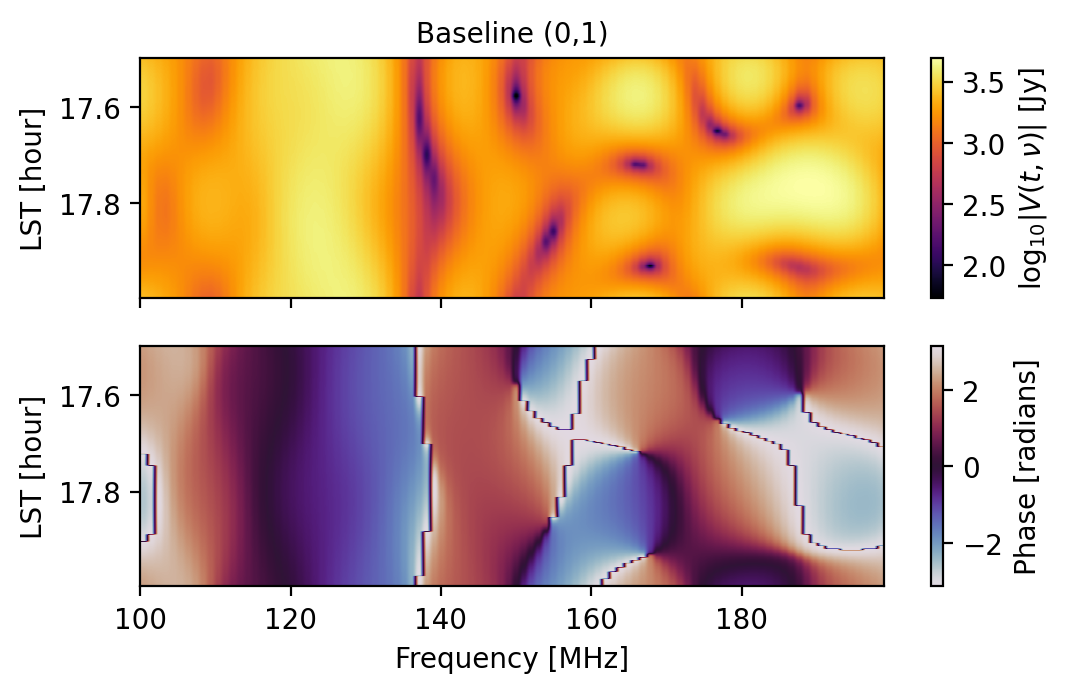
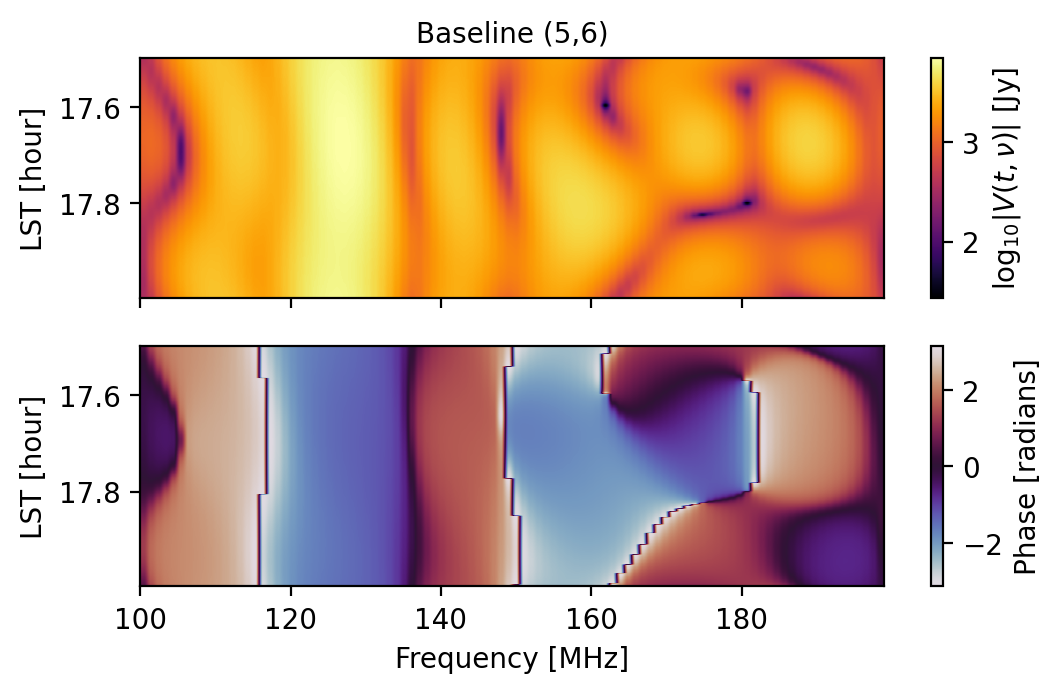
We can ensure that a simulated effect that should be redundant is redundant by specifying that we use a “redundant” seed:
[16]:
sim.refresh() # Clear the contents and zero the data
sim.add(
"diffuse_foreground",
seed="redundant", # Use the same random state for each redundant group
)
[17]:
np.all(sim.get_data(0,1,"xx") == sim.get_data(5,6,"xx"))
[17]:
True
[18]:
# Let's plot them again in case the direct comparison wasn't enough.
fig1 = waterfall(sim, antpairpol=(0,1,"xx"), title="Baseline (0,1)")
fig2 = waterfall(sim, antpairpol=(5,6,"xx"), title="Baseline (5,6)")
FixedFormatter should only be used together with FixedLocator
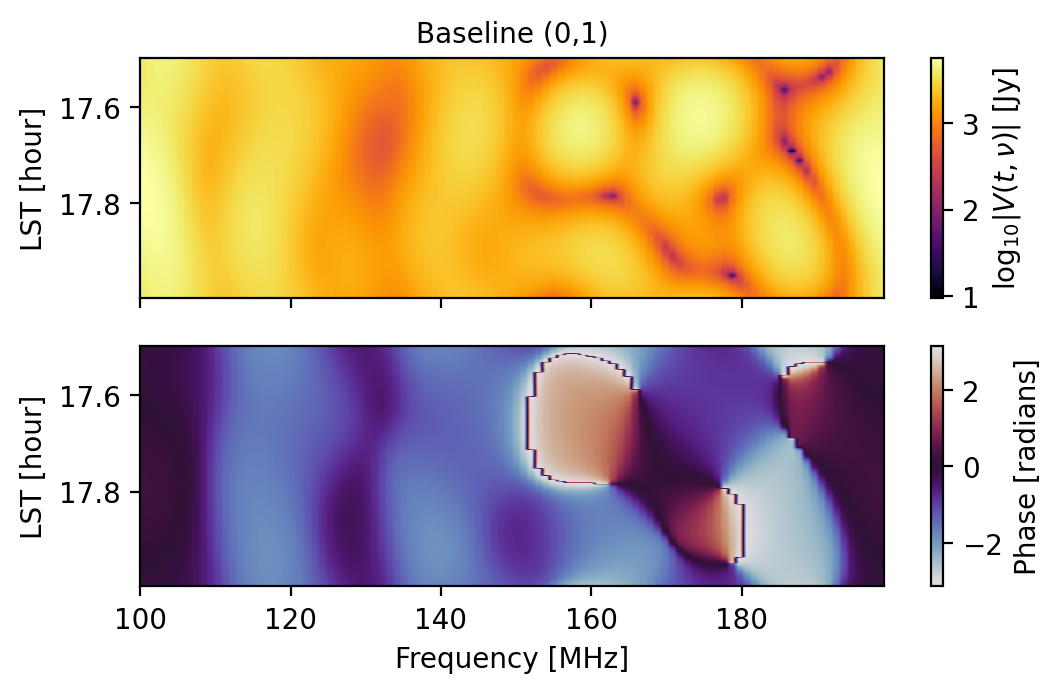
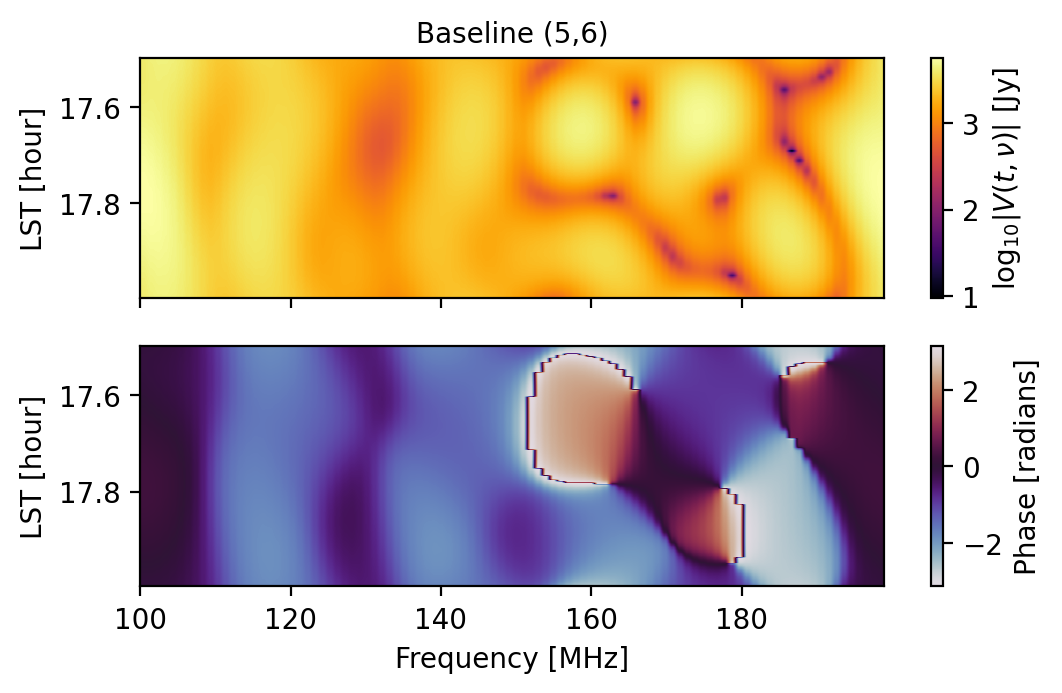
It is worth noting that the get_data method used here is the pyuvdata.UVData method that has been exposed to the Simulator, not to be confused with the get method of the Simulator, but more on that later.
[19]:
# Go one step further with this example.
all_redundant = True
for red_grp in sim.red_grps:
if len(red_grp) == 1:
continue # Nothing to see here
base_vis = sim.get_data(red_grp[0])
# Really check that data is redundant.
for baseline in red_grp[1::]:
all_redundant &= np.allclose(base_vis, sim.get_data(baseline))
all_redundant
[19]:
True
Retrieving Simulated Effects¶
The parameter values used for simulating an effect are stored so that the effect may be recovered at a later time by re-simulating the effect. For effects that have a random element (like bandpass gains or thermal noise), you’ll want to make sure that the seed parameter is specified to ensure that the random state can be configured appropriately.
[20]:
sim.refresh()
vis = sim.add(
"noiselike_eor",
eor_amp=1e-3,
seed="redundant",
ret_vis=True, # Return a copy of the visibility for comparison later
)
sim.add(
"gains", # Apply a bandpass to the EoR data
seed="once", # Use the same seed each pass through the loop
)
As an extra note regarding the "once" setting used to set the random state in the above cell, this setting ensures that the same random state is used each iteration of the loop over the array. This isn’t strictly necessary to use for multiplicative effects, since these are computed once before iterating over the array, but should be used for something like point-source foregrounds (which randomly populates the sky with sources each time the model is called).
[21]:
# The data has been modified by the gains, so it won't match the original.
np.allclose(vis, sim.data.data_array)
[21]:
False
[22]:
# We can recover the simulated effect if we wanted to, though.
np.allclose(vis, sim.get("noiselike_eor"))
[22]:
True
It is worth highlighting that the get method does not retrieve cached data (since simulated effects are not cached), but rather re-simulates the effect using the same parameter values and random states (since these are cached).
[23]:
# Make explicitly clear that the simulated effects are not cached
vis is sim.get("noiselike_eor")
[23]:
False
[24]:
# Show that the same effect really is recovered.
gains = sim.get("gains")
new_vis = vis.copy()
for ant1, ant2, pol, blt_inds, pol_ind in sim._iterate_antpair_pols():
# Modify the old visibilities by the complex gains manually.
total_gain = gains[(ant1, pol[0])] * np.conj(gains[(ant2, pol[1])])
new_vis[blt_inds,0,:,pol_ind] *= total_gain
np.allclose(new_vis, sim.data.data_array) # Now check that they match.
[24]:
True
Each time a component is added to the simulation, it is logged in the history:
[25]:
print(sim.data.history)
hera_sim v1.0.1.dev14+ga590958: Added noiselikeeor using parameters:
eor_amp = 0.001
fringe_filter_type = tophat
hera_sim v1.0.1.dev14+ga590958: Added bandpass using parameters:
bp_poly = <hera_sim.interpolators.Bandpass object at 0x7f124d22d550>
Saving A Simulation¶
Finally, we’ll often want to write simulation data to disk. The simplest way to do this is with the write method:
[26]:
tempdir = Path(tempfile.mkdtemp())
filename = tempdir / "simple_example.uvh5"
sim.write(filename, save_format="uvh5")
[27]:
filename in tempdir.iterdir()
[27]:
True
[28]:
# Check that the data is the same.
sim2 = Simulator(data=filename)
is_equiv = True
# Just do a basic check.
for attr in ("data_array", "freq_array", "time_array", "antenna_positions"):
is_equiv &= np.all(getattr(sim.data, attr) == getattr(sim2.data, attr))
is_equiv
Telescope hera_sim is not in known_telescopes.
[28]:
True
This concludes the section on basic use of the Simulator.
Advanced Use¶
The preceding examples should provide enough information to get you started with the Simulator. The rest of this notebook shows some of the more advanced features offered by the Simulator.
Singling Out Baselines/Antennas/Polarizations¶
It is possible to simulate an effect for only a subset of antennas, baselines, and/or polarizations by making use of the vis_filter parameter when using the add method. Below are some examples.
[29]:
sim.refresh()
vis_filter = [(0,1), (3,6)] # Only do two baselines
sim.add("diffuse_foreground", vis_filter=vis_filter)
for baseline in sim.data.get_antpairs():
if np.any(sim.get_data(baseline)):
print(f"Baseline {baseline} has had an effect applied.")
Baseline (1, 0) has had an effect applied.
Baseline (6, 3) has had an effect applied.
You have not specified how to seed the random state. This effect might not be exactly recoverable.
[30]:
vis_filter = [1,] # Apply gains to only one antenna
vis_A = sim.get_data(0, 1)
vis_B = sim.get_data(3, 6)
sim.add("gains", vis_filter=vis_filter)
np.allclose(vis_A, sim.get_data(0, 1)), np.allclose(vis_B, sim.get_data(3, 6))
[30]:
(False, True)
[31]:
# Now something a little more complicated.
hera_sim.defaults.deactivate() # Use the same initial params, but 2 pol
sim = Simulator(polarization_array=["xx", "yy"], **sim_params)
hera_sim.defaults.activate()
# Actually calculate the effects for the example.
vis_filter = [(0,1,"yy"), (0,2,"yy"), (1,2,"yy")]
sim.add("noiselike_eor", vis_filter=vis_filter)
for antpairpol, vis in sim.data.antpairpol_iter():
if np.any(vis):
print(f"Antpairpol {antpairpol} has had an effect applied.")
# Apply gains only to antenna 0
vis_A = sim.get_data(0, 1, "yy")
vis_B = sim.get_data(0, 2, "yy")
vis_C = sim.get_data(1, 2, "yy")
sim.add("gains", vis_filter=[0,])
(
np.allclose(vis_A, sim.get_data(0, 1, "yy")),
np.allclose(vis_B, sim.get_data(0, 2, "yy")),
np.allclose(vis_C, sim.get_data(1, 2, "yy")),
)
You have not specified how to seed the random state. This effect might not be exactly recoverable.
Antpairpol (1, 0, 'yy') has had an effect applied.
Antpairpol (2, 0, 'yy') has had an effect applied.
Antpairpol (2, 1, 'yy') has had an effect applied.
[31]:
(False, False, True)
For some insight into what’s going on under the hood, this feature is implemented by recursively checking each entry in vis_filter and seeing if the current baseline + polarization (in the loop that simulates the effect for every baseline + polarization) matches any of the keys provided in vis_filter. If any of the keys are a match, then the filter says to simulate the effect—this is important to note because it can lead to some unexpected consequences. For example:
[32]:
seed = 12345 # Ensure that the random components are identical.
sim.refresh()
vis_filter = [(0,1), "yy"]
vis_A = sim.add(
"diffuse_foreground",
vis_filter=vis_filter,
ret_vis=True,
seed=seed,
)
sim.refresh()
vis_filter = [(0,1,"yy"),]
vis_B = sim.add(
"diffuse_foreground",
vis_filter=vis_filter,
ret_vis=True,
seed=seed,
)
np.allclose(vis_A, vis_B)
[32]:
False
[33]:
# In case A, data was simulated for both polarizations for baseline (0,1)
blt_inds = sim.data.antpair2ind(0, 1, ordered=False)
np.all(vis_A[blt_inds])
[33]:
True
[34]:
# As well as every baseline for polarization "yy"
np.all(vis_A[...,1])
[34]:
True
[35]:
# Only baseline (0,1) had an effect simulated for polarization "xx"
np.all(vis_A[...,0])
[35]:
False
[36]:
# Whereas for case B, only baseline (0, 1) with polarization "yy"
# had the simulated effect applied.
(
np.all(vis_B[blt_inds,...,1]), # Data for (0, 1, "yy")
np.all(vis_B[blt_inds]), # Data for both pols of (0, 1)
np.all(vis_B[...,1]), # Data for all baselines with pol "yy"
)
[36]:
(True, False, False)
Here’s an example of how the vis_filter parameter can be used to simulate a single antenna that is especially noisy.
[37]:
hera_sim.defaults.deactivate() # Pause the H1C defaults for a moment...
sim = Simulator(**sim_params) # Only need one polarization for this example.
hera_sim.defaults.activate() # Turn the defaults back on for simulating effects.
# Start by adding some foregrounds.
sim.add("diffuse_foreground", seed="redundant")
# Then add noise with a receiver temperature of 100 K to all baselines
# except those that contain antenna 0.
v = sim.get_data(0, 1)
vis_filter = [antpair for antpair in sim.get_antpairs() if 0 not in antpair]
sim.add("thermal_noise", Trx=100, seed="initial", vis_filter=vis_filter)
# Now make antenna 0 dramatically noisy.
sim.add(
"thermal_noise",
Trx=5e4,
seed="initial",
vis_filter=[0,],
component_name="noisy_ant",
)
[38]:
# Recall that baselines (0,1) and (2,3) are redundant,
# so the only difference here is the noise.
jansky_to_kelvin = utils.jansky_to_kelvin(
sim.freqs,
hera_sim.defaults('omega_p'),
)
Tsky_A = sim.get_data(0, 1) * jansky_to_kelvin
Tsky_B = sim.get_data(2, 3) * jansky_to_kelvin
np.std(np.abs(Tsky_A)), np.std(np.abs(Tsky_B))
[38]:
(50.151933214628464, 47.48252263186864)
Notice that the final call to the add method specified a value for the parameter component_name. This is especially useful when simulating an effect multiple times using the same class, as we have done here. As currently implemented, the Simulator would normally overwrite the parameters from the first application of noise with the parameters from the second application of noise; however, by specifying a name for the second application of noise, we can recover the two effects
independently:
[39]:
vis_A = sim.get("thermal_noise")
vis_B = sim.get("noisy_ant")
blt_inds = sim.data.antpair2ind(0, 1)
(
np.any(vis_A[blt_inds]), # The first application give (0, 1) noise,
np.all(vis_B[blt_inds]), # but the second application did.
)
[39]:
(False, True)
With that, we conclude this section of the tutorial. This section should have provided you with sufficient examples to add effects to your own simulation in rather complicated ways—we recommend experimenting a bit on your own!
Naming Components¶
This was briefly touched on in the previous section, but it is interesting enough to get its own section. By using the component_name parameter, it is possible to use the same model multiple times for simulating an effect and have the Simulator be able to recover every different effect simulated using that model. Here are some examples:
[40]:
hera_sim.defaults.set("debug")
sim = Simulator(
Ntimes=6*24, # Do a full day
integration_time=10*60, # In 10 minute increments
Nfreqs=100, # Just to make the plots look nicer
)
sim.add(
"pntsrc_foreground",
nsrcs=5000, # A lot of sources
Smin=0.01,
Smax=0.5, # That are relatively faint
component_name="faint sources",
seed="once",
)
sim.add(
"pntsrc_foreground",
nsrcs=10, # Just a few sources
Smin=0.5,
Smax=10, # That are bright
component_name="bright_sources",
seed="once",
)
[41]:
# Let's look at the data. First, we need to recover it.
faint_srcs = sim.get("faint sources", key=(0,1,"xx"))
bright_srcs = sim.get("bright_sources", key=(0,1,"xx"))
# Now let's get ready to plot.
fig, (ax1, ax2) = plt.subplots(nrows=2, ncols=1, figsize=(6,3.5), dpi=200)
# Use a common colorscale
vmin = min(np.abs(faint_srcs).min(), np.abs(bright_srcs).min())
vmax = max(np.abs(faint_srcs).max(), np.abs(bright_srcs).max())
# Actually make the plots
fig, ax1 = labeled_waterfall(
faint_srcs,
freqs=sim.freqs * units.GHz.to("Hz"),
lsts=sim.lsts,
set_title="Faint Sources",
ax=ax1,
mode="abs",
vmin=vmin,
vmax=vmax,
)
ax1.xaxis.set_visible(False)
fig, ax2 = labeled_waterfall(
bright_srcs,
freqs=sim.freqs * units.GHz.to("Hz"),
lsts=sim.lsts,
set_title="Bright Sources",
mode="abs",
ax=ax2,
vmin=vmin,
vmax=vmax,
)
fig.tight_layout()
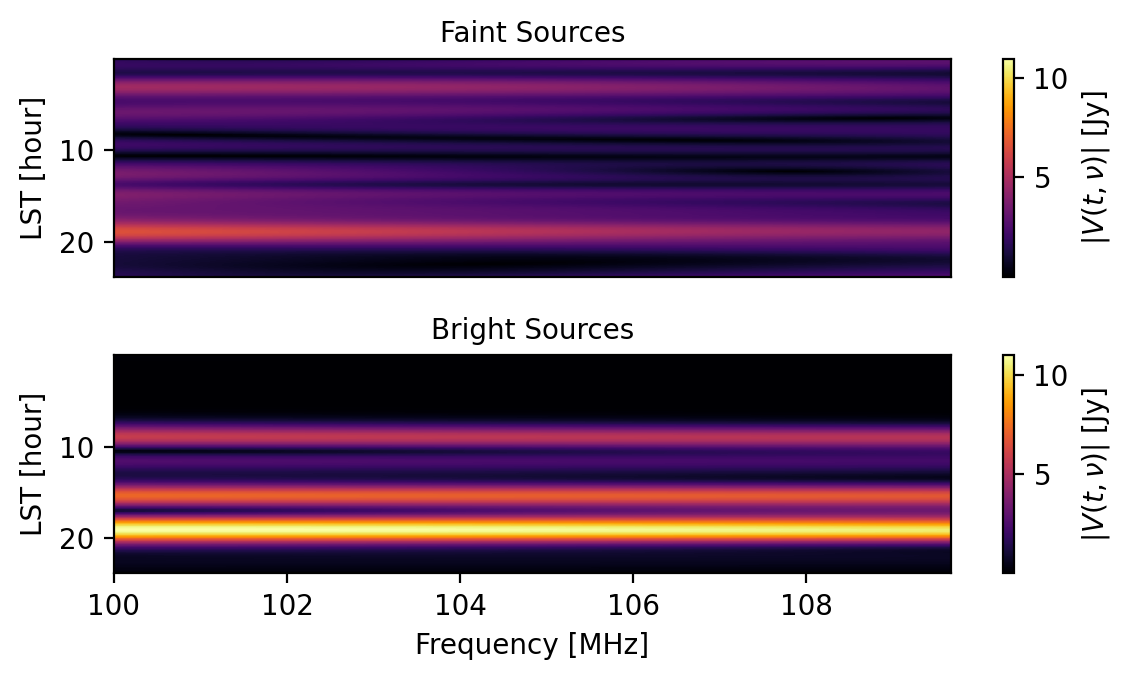
So, by setting a value for the component_name parameter when calling the add method, it is possible to use a single model for simulating multiple different effects and later on recover the individual effects.
Pre-Computing Fringe-Rate/Delay Filters¶
Some of the effects that are simulated utilize a fringe-rate filter and/or a delay filter in order to add to the realism of the simulation while keeping the computational overhead relatively low. Typically these filters are calculated on the fly; however, this can start to become an expensive part of the calculation for very large arrays. In order to address this, we implemented the ability to pre-compute these filters and use the cached filters instead. Here’s an example.
[42]:
# Make a big array with a high degree of redundancy.
big_array = hera_sim.antpos.hex_array(6, split_core=False, outriggers=0)
hera_sim.defaults.set("debug") # Use short time and frequency axes.
sim = Simulator(array_layout=big_array)
delay_filter_kwargs = {"standoff": 30, "delay_filter_type": "gauss"}
fringe_filter_kwargs = {"fringe_filter_type": "gauss", "fr_width": 1e-4}
seed = 12345
[43]:
# First, let's simulate an effect without pre-computing the filters.
vis_A = sim.add(
"diffuse_foreground",
delay_filter_kwargs=delay_filter_kwargs,
fringe_filter_kwargs=fringe_filter_kwargs,
seed=seed,
ret_vis=True,
)
[44]:
# Now do it using the pre-computed filters.
sim.calculate_filters(
delay_filter_kwargs=delay_filter_kwargs,
fringe_filter_kwargs=fringe_filter_kwargs,
)
vis_B = sim.add("diffuse_foreground", seed=seed, ret_vis=True)
[45]:
# Show that we get the same result.
np.allclose(vis_A, vis_B)
[45]:
True
The above example shows how to use the filter caching mechanism and that it produces results that are identical to those when the filters are calculated on the fly, provided the filters are characterized the same way. Note, however, that this feature is still experimental and extensive benchmarking needs to be done to determine when it is beneficial to use the cached filters.
Using Custom Models¶
In addition to using the models provided by hera_sim, it is possible to make your own models and add an effect to the simulation using the custom model and the Simulator. If you would like to do this, then you need to follow some simple rules for writing the custom model:
A component base class must be defined using the
@componentdecorator.Models must inherit from the component base class.
The model call signature must have
freqsas a parameter. Additive components (like visibilities) must also takelstsas a parameter.Additive components must return a
np.ndarraywith shape(lsts.size, freqs.size).Multiplicative components must have a class attribute
is_multiplicativethat is set toTrue, and they must return a dictionary mapping antenna numbers tonp.ndarrays with shape(freqs.size,)or(lsts.size, freqs.size).
Frequencies will always be passed in units of GHz, and LSTs will always be passed in units of radians.
An example of how to do this is provided in the following section.
Registering Classes¶
[46]:
# Minimal example for using custom classes.
# First, make the base class that the custom model inherits from.
from hera_sim import component
@component
class Example:
# The base class doesn't *need* a docstring, but writing one is recommended
pass
class TestAdd(Example):
def __init__(self):
pass
def __call__(self, lsts, freqs):
return np.ones((len(lsts), len(freqs)), dtype=complex)
sim.refresh()
sim.add(TestAdd) # You can add the effect by directly referencing the class
np.all(sim.data.data_array == 1)
You have not specified how to seed the random state. This effect might not be exactly recoverable.
[46]:
True
[47]:
# Now for a multiplicative effect
class TestMult(Example):
is_multiplicative = True
def __init__(self):
pass
def __call__(self, freqs, ants):
return {ant: i * np.ones_like(freqs) for i, ant in enumerate(ants)}
mult_model = TestMult()
sim.add(mult_model) # You can also use an instance of the class
np.all(sim.get_data(1,2) == 2)
[47]:
True
[48]:
# You can also give the class an alias it may be referenced by
class TestAlias(Example):
is_multiplicative = False
_alias = ("bias",)
def __init__(self):
pass
def __call__(self, lsts, freqs, bias=10):
return bias * np.ones((lsts.size, freqs.size), dtype=complex)
sim.refresh()
sim.add("bias") # Or you can just use the name (or an alias) of the model
np.all(sim.data.data_array == 10)
[48]:
True
How does this work? Basically all that happens is that the @component decorator ensures that every model that is subclassed from the new simulation component is tracked in the component’s _models attribute.
[49]:
Example._models
[49]:
{'testadd': __main__.TestAdd,
'testmult': __main__.TestMult,
'testalias': __main__.TestAlias,
'bias': __main__.TestAlias}
It is also worth noting that you can make new models from components that already exist in hera_sim! We could, for example, make a new RFI model like so:
[50]:
class NewRFI(hera_sim.rfi.RFI):
_alias = ("example_rfi",)
"""Doesn't do anything, just an example."""
def __init__(self, **kwargs):
super().__init__(**kwargs)
def __call__(self, lsts, freqs):
"""This class will be added to the list of known components, though!"""
return np.zeros((lsts.size, freqs.size), dtype=complex)
In case it isn’t clear: defining a new simulation component and making a model of that component makes hera_sim automatically aware of its existence, and so the Simulator is able to find it with ease (provided there isn’t a name conflict). See the last entry of the following text.
[51]:
print(hera_sim.components.list_all_components())
array:
lineararray
hexarray
foreground:
diffuseforeground | diffuse_foreground
pointsourceforeground | pntsrc_foreground
noise:
thermalnoise | thermal_noise
rfi:
stations | rfi_stations
impulse | rfi_impulse
scatter | rfi_scatter
dtv | rfi_dtv
newrfi | example_rfi
gain:
bandpass | gains | bandpass_gain
reflections | reflection_gains | sigchain_reflections
crosstalk:
crosscouplingcrosstalk | cross_coupling_xtalk
crosscouplingspectrum | cross_coupling_spectrum | xtalk_spectrum
whitenoisecrosstalk | whitenoise_xtalk | white_noise_xtalk
eor:
noiselikeeor | noiselike_eor
example:
testadd
testmult
testalias | bias
Saving Data in Chunks¶
We finally get to the last of the advanced features of the Simulator: writing data to disk in a way that resembles how the correlator writes HERA data to disk. HERA data files typically only contain a few integrations, and follow a standard naming convention. With the chunk_sim_and_save method, you can write files to disk so that they are chunked into a set number of integrations per file and follow a particular naming scheme. Here’s an example:
[52]:
# We'll use a new temporary directory
tempdir = Path(tempfile.mkdtemp())
sim.chunk_sim_and_save(
save_dir=tempdir, # Write the files to tempdir
Nint_per_file=2, # Include 2 integrations per file
prefix="example", # Prefix the file basename with "example"
sky_cmp="custom", # Tack on "custom" after the JD in the filename
state="true", # Tack on "true" after "custom" in the filename
filetype="uvh5", # Use the uvh5 file format
)
[53]:
print("\n".join(str(f) for f in tempdir.iterdir()))
/tmp/tmpbyom8sqz/example.2458119.50099.custom.true.uvh5
/tmp/tmpbyom8sqz/example.2458119.50173.custom.true.uvh5
/tmp/tmpbyom8sqz/example.2458119.50223.custom.true.uvh5
/tmp/tmpbyom8sqz/example.2458119.50198.custom.true.uvh5
/tmp/tmpbyom8sqz/example.2458119.50124.custom.true.uvh5
/tmp/tmpbyom8sqz/example.2458119.50050.custom.true.uvh5
/tmp/tmpbyom8sqz/example.2458119.50025.custom.true.uvh5
/tmp/tmpbyom8sqz/example.2458119.50000.custom.true.uvh5
/tmp/tmpbyom8sqz/example.2458119.50074.custom.true.uvh5
/tmp/tmpbyom8sqz/example.2458119.50149.custom.true.uvh5
The filename format is save_dir/[{prefix}.]{jd_major}.{jd_minor}[.{sky_cmp}][.{state}].{filetype}. Note that this hasn’t been tested with other filetypes (e.g. miriad), so results may vary if you deviate from the uvh5 format.
It’s also possible to provide reference files for deciding how to chunk the files:
[54]:
sim.chunk_sim_and_save(
save_dir=tempdir,
ref_files=list(tempdir.iterdir()),
prefix="new",
sky_cmp="example",
state="files",
filetype="uvh5",
)
Telescope hera_sim is not in known_telescopes.
Telescope hera_sim is not in known_telescopes.
Telescope hera_sim is not in known_telescopes.
Telescope hera_sim is not in known_telescopes.
Telescope hera_sim is not in known_telescopes.
Telescope hera_sim is not in known_telescopes.
Telescope hera_sim is not in known_telescopes.
Telescope hera_sim is not in known_telescopes.
Telescope hera_sim is not in known_telescopes.
Telescope hera_sim is not in known_telescopes.
[55]:
print("\n".join(str(f) for f in tempdir.iterdir() if str(f).endswith("files.uvh5")))
/tmp/tmpbyom8sqz/new.2458119.50025.example.files.uvh5
/tmp/tmpbyom8sqz/new.2458119.50099.example.files.uvh5
/tmp/tmpbyom8sqz/new.2458119.50149.example.files.uvh5
/tmp/tmpbyom8sqz/new.2458119.50000.example.files.uvh5
/tmp/tmpbyom8sqz/new.2458119.50223.example.files.uvh5
/tmp/tmpbyom8sqz/new.2458119.50074.example.files.uvh5
/tmp/tmpbyom8sqz/new.2458119.50198.example.files.uvh5
/tmp/tmpbyom8sqz/new.2458119.50050.example.files.uvh5
/tmp/tmpbyom8sqz/new.2458119.50124.example.files.uvh5
/tmp/tmpbyom8sqz/new.2458119.50173.example.files.uvh5
The run_sim Method¶
The Simulator class also features the run_sim method, which allows you to run an entire simulation with a single method call. The idea behind this is that one might want to decide all of the simulation parameters beforehand, or have a configuration file specifying the simulation parameters, and then run the entire simulation in one go. Below are some examples of how to use the run_sim method.
Defining A Configuration Dictionary¶
We can specify a sequence of steps to be simulated by using a dictionary that maps models to dictionaries that specify their parameter values. This simulation will include diffuse foregrounds, a noiselike EoR signal, and bandpass gains.
[56]:
hera_sim.defaults.deactivate()
sim = Simulator(**sim_params)
config = {
"diffuse_foreground":
{
"Tsky_mdl": hera_sim.defaults("Tsky_mdl"),
"omega_p": np.ones_like(sim.freqs),
},
"noiselike_eor": {"eor_amp": 1e-4},
"gains": {"dly_rng": (-50, 50)},
}
sim.run_sim(**config)
You have not specified how to seed the random state. This effect might not be exactly recoverable.
[57]:
# Let's take a look at some of the data
fig = waterfall(sim)
FixedFormatter should only be used together with FixedLocator
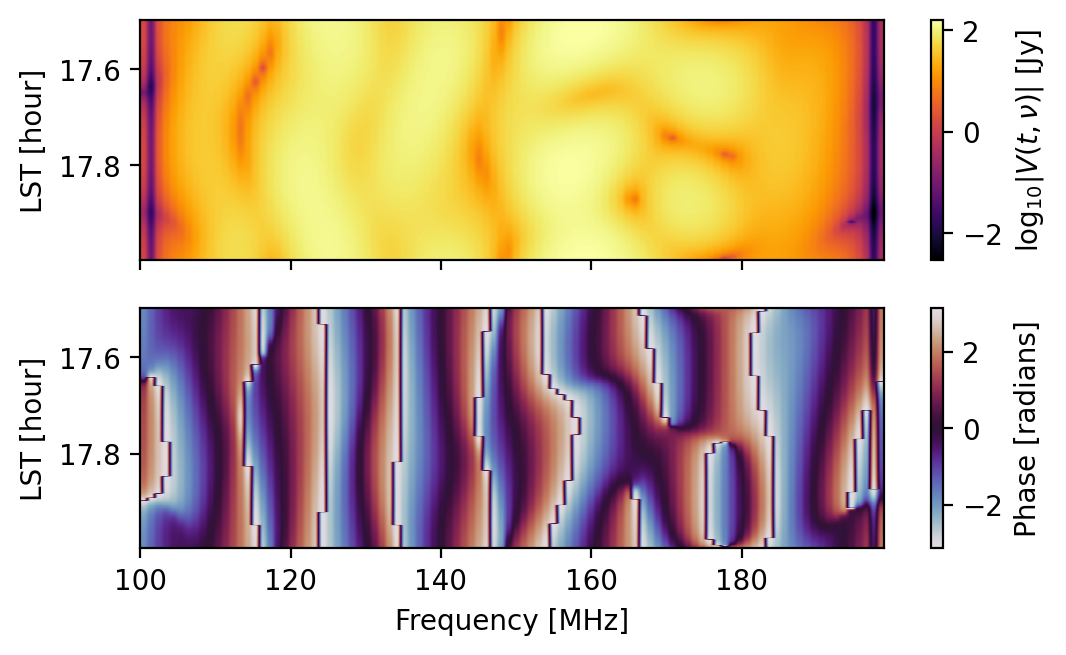
[58]:
# Now let's verify that the simulation contains what we want.
print(sim.data.history)
hera_sim v1.0.1.dev14+ga590958: Added diffuseforeground using parameters:
Tsky_mdl = <hera_sim.interpolators.Tsky object at 0x7f124cc5b850>
omega_p = [1. 1. 1. 1. 1. 1. 1. 1. 1. 1. 1. 1. 1. 1. 1. 1. 1. 1. 1. 1. 1. 1. 1. 1.
1. 1. 1. 1. 1. 1. 1. 1. 1. 1. 1. 1. 1. 1. 1. 1. 1. 1. 1. 1. 1. 1. 1. 1.
1. 1. 1. 1. 1. 1. 1. 1. 1. 1. 1. 1. 1. 1. 1. 1. 1. 1. 1. 1. 1. 1. 1. 1.
1. 1. 1. 1. 1. 1. 1. 1. 1. 1. 1. 1. 1. 1. 1. 1. 1. 1. 1. 1. 1. 1. 1. 1.
1. 1. 1. 1.]
hera_sim v1.0.1.dev14+ga590958: Added noiselikeeor using parameters:
eor_amp = 0.0001
hera_sim v1.0.1.dev14+ga590958: Added bandpass using parameters:
dly_rng = (-50, 50)
Using A Configuration File¶
Instead of using a dictionary to specify the parameters, we can instead use a configuration YAML file:
[59]:
cfg_file = tempdir / "config.yaml"
cfg_file.touch()
with open(cfg_file, "w") as cfg:
cfg.write(
"""
pntsrc_foreground:
nsrcs: 10000
Smin: 0.2
Smax: 20
seed: once
noiselike_eor:
eor_amp: 0.005
seed: redundant
reflections:
amp: 0.01
dly: 200
seed: once
"""
)
sim.refresh()
sim.run_sim(sim_file=cfg_file)
[60]:
# Again, let's check out some data.
fig = waterfall(sim)
FixedFormatter should only be used together with FixedLocator
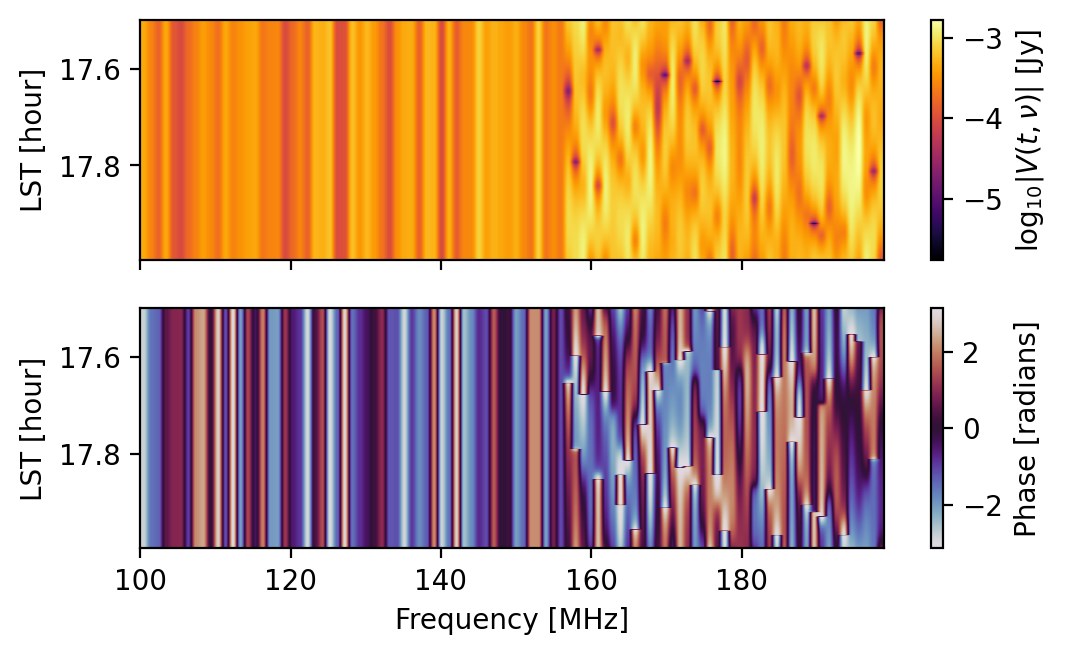
[61]:
# Then verify the history.
print(sim.data.history)
hera_sim v1.0.1.dev14+ga590958: Added pointsourceforeground using parameters:
nsrcs = 10000
Smin = 0.2
Smax = 20
hera_sim v1.0.1.dev14+ga590958: Added noiselikeeor using parameters:
eor_amp = 0.005
hera_sim v1.0.1.dev14+ga590958: Added reflections using parameters:
amp = 0.01
dly = 200
[ ]: